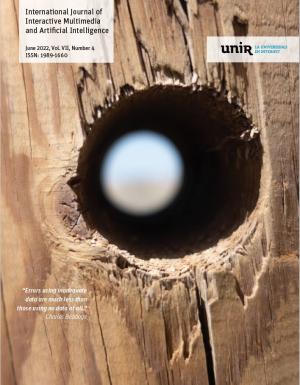Research on the Application of Computer Graphic Advertisement Design Based on a Genetic Algorithm and TRIZ Theory.
DOI:
https://doi.org/10.9781/ijimai.2021.08.007Keywords:
TRIZ Theory, Genetic Algorithms, Print Advertising, Innovative Thinking, Content ArrangementAbstract
In view of the shortcomings of the traditional thinking of computer graphic advertising design, this paper introduces TRIZ innovative thinking to design computer advertising. First of all, combined with specific cases of computer creative print advertising, this paper analyzes the creative methods of stimulating divergent thinking, aggregation thinking and transformation thinking from the innovation principle of TRIZ theory as the origin, and applies them to the creative mechanism and application program of print advertising creativity. The whole process is led by rational principles of perceptual thinking, driven by specific principles of abstract imagination, to explore the thinking source of creative design essence of print advertising. The theory and its application mechanism become a new thinking method and application attempt in the creative field of print advertisement. Then, based on the TRIZ innovation theory, the business model of advertising content arrangement is constructed, and the mathematical model is constructed according to the planning business media resource planning on the business model to realize the multi-objective optimization of efficient use of orders and precise delivery of time. Finally, a multi-objective optimization mathematical model of parallel genetic algorithm is designed to solve the advertisement content arrangement. The innovative thinking of TRIZ and the application of genetic algorithm in content arrangement of computer graphic advertisement design are verified by experiments.
Downloads
References
C. H. Lee, C. H. Chen, F. Li, A. J. Shie, “Customized and knowledge-centric service design model integrating case-based reasoning and TRIZ,” Expert Systems with Applications, vol. 143, pp. 113062, 2020, https://doi.org/10.1016/j.eswa.2019.113062
F. Li. “A Study on Innovative Design of Rotary Pile Foundation Drilling Machine Based on TRIZ Theory,” In International Conference on Mechanical Design, Springer, Singapore, 2019, pp. 302-309.
N. Şen, Y. Baykal. “Development of car wishbone using sheet metal tearing process via the theory of inventive problem-solving (TRIZ) method”, Journal of the Brazilian Society of Mechanical Sciences and Engineering, vol. 41, no. 10, pp. 390, 2019, https://doi.org/10.1007/s40430- 019-1884-7.
F. Jiang, J. Shen, T. Zhu, J. Wen. “Design of Flagstone Transport Device Based on TRIZ Theory”, In International Conference on Mechanical Design, Springer, Singapore, 2019, pp. 253-266.
D. Russo, C. Spreafico, M. Spreafico. “A Simplified TRIZ Approach Involving Technology Transfer for Reducing Product Energy Consumption”, In Sustainable Design and Manufacturing, Springer, Singapore, 2020, pp. 129-138.
H. D. García-Manilla, J. Delgado-Maciel, D. Tlapa-Mendoza, Y. A. Báez López, L. Riverda-Cadavid. “Integration of design thinking and TRIZ Theory to assist a user in the formulation of an innovation project”, In Managing innovation in highly restrictive environments, Springer, Cham, 2019, pp. 303-327.
K. Hmina, M. Sallaou, A. Arbaoui, L. Lasri. “A preliminary design innovation aid methodology based on energy analysis and TRIZ tools exploitation”, International Journal on Interactive Design and Manufacturing, vol. 12, no. 3, pp. 919-928, 2018, https://doi.org/10.1007/s12008-017-0455-3
G. Bersano, P. E. Fayemi. “Application of TRIZ and Innovation Management Theory on Decision Support for Transport Infrastructure”, In International TRIZ Future Conference, Springer, Cham, 2019, pp. 486-493.
P. Livotov, A. P. C. Sekaran, R. Law, Reay. D. “Systematic Innovation in Process Engineering: Linking TRIZ and Process Intensification”, In Advances in Systematic Creativity, Palgrave Macmillan, Cham, 2019, pp. 27-44.
S. Purnamawati, E. B. Nababan, B. Tsani, R. Taqyuddin, R. F. Rahmat. “Advertisement scheduling on commercial radio station using genetics algorithm”, 2nd International Conference on Computing and Applied Informatics, Medan, Indonesia, 2017, pp. 28–30.
Q. Madera, O. Castillo, M. Garcia, A. Mancilla. “Interactive evolutionary computation with adaptive mutation for increasing the effectiveness of advertisement texts”, In 2016 IEEE Symposium Series on Computational Intelligence, IEEE, 2016, pp. 1-6.
G. T. Reddy, M. P. K. Reddy, K. Lakshmanna, D. S. Rajput, R. Kaluri, G. Srivastava. “Hybrid genetic algorithm and a fuzzy logic classifier for heart disease diagnosis”, Evolutionary Intelligence, vol. 13, no. 2, pp. 185-196, 2020, https://doi.org/10.1007/s12065-019-00327-1
L. Qin, W. Huang, Y. Du, L. Zheng, M. K. Jawed. “Genetic algorithm-based inverse design of elastic gridshells”, Structural and Multidisciplinary Optimization, vol. 62, pp. 2691-2707, 2020, https://doi.org/10.1007/s00158-020-02639-8
M. Guo. “A Study on Data Mining of Digital Display Performance of Brand Advertisement”, Wireless Personal Communications, vol. 102, no. 2, pp. 1243-1253, 2018, https://doi.org/10.1007/s11277-017-5180-5
K. M. Hamdia, X. Zhuang, T. Rabczuk. “An efficient optimization approach for designing machine learning models based on genetic algorithm”, Neural Computing and Applications, vol. 33, pp. 923–1933, 2021, https://doi.org/10.1007/s00521-020-05035-x
Z. Zhou, F. Li, H. Zhu, H. Xie, J. H. Abawajy, M. U. Chowdhury. “An improved genetic algorithm using greedy strategy toward task scheduling optimization in cloud environments”, Neural Computing and Applications, vol. 32, no. 6, pp. 1531-1541, 2020, https://doi.org/10.1007/s00521-019-04119-7
H. Chung, K. S. Shin. “Genetic algorithm-optimized multi-channel convolutional neural network for stock market prediction”, Neural Computing and Applications, vol. 32, no.12, pp. 7897-7914, 2020, https://doi.org/10.1007/s00521-019-04236-3
J. Tian, M. Gao, G. Ge. “Wireless sensor network node optimal coverage based on improved genetic algorithm and binary ant colony algorithm”, EURASIP Journal on Wireless Communications and Networking, 2016:104, 2016, doi: 10.1186/s13638-016-0605-5.
T. L. Chen, C. Y. Cheng, Y. H. Chou. “Multi-objective genetic algorithm for energy-efficient hybrid flow shop scheduling with lot streaming”, Annals of Operations Research, vol. 290, pp. 813-836, 2020, https://doi.org/10.1007/s10479-018-2969-x
N. Malarvizhi, P. Selvarani, P. Raj. “Adaptive fuzzy genetic algorithm for multi biometric authentication”, Multimedia Tools and Applications, Vol.79. no.13, pp. 9131-9144, 2020, https://doi.org/10.1007/s11042-019-7436-4
C. Ma, W. Hao, F. Pan, W. Xiang. “Road screening and distribution route multi-objective robust optimization for hazardous materials based on neural network and genetic algorithm”, PLoS One, vol. 13, no. 6, pp. e0198931, 2018, https://doi.org/10.1371/journal.pone.0198931
A. Mondal, J. M. Young, T. A. Barckholtz, G. Kiss, L. Koziol, A. Z. Panagiotopoulos. “Genetic algorithm driven force field parameterization for molten alkali-metal carbonate and hydroxide salts”, Journal of Chemical Theory and Computation, vol. 16, no. 9, pp. 5736-5746, 2020, http://dx.doi.org/10.1021/acs.jctc.0c00285
Downloads
Published
-
Abstract187
-
PDF28









